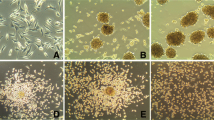Abstract
Objective: To study the role of connexin gene (Cx 43) on the development of glioma and the feasibility of using Cx43cDNA as a target of gene therapy of gliomas. Methods: Parental rat C6 cells and C6 cells transfected with Cx43cDNA were implanted into right caudate nucleus of SD rats as control and transfected group. Rats bearing cerebral C6 gliomas were treated with Cx43cDNA and empty vector as treated group and empty vector group. The general manifestation, survival time, MRI dynamic scanning and histopathological changes of all rats were observed.In situ hybridization and immunohisto- chemistry were used for examination of Cx43mRNA and its protein in gliomas. Average number of AgNOR staining was used for detection of cell proliferation activity, and TUNEL method for determination of cell apoptosis. Results: All rats in control and empty vector group died of cerebral gliomas within 3 weeks after implantation of C6 cells. Six out of nine rats in the transfected group and eight out of ten rats in treated group kept alive beyond 120 days with totally disappearing of the tumor foci, except one treated rat having a little residue of tumor. In gliomas of transfected and treated groups Cx43 gene expression was upregulated, proliferation activity was lowered, However, the apoptotic cells did not increase. Conclusion: The present study indicates that Cx43 gene is of crucial importance in the development of malignant glioma. It can be an effective target for gene therapy of gliomas.
Similar content being viewed by others
References
Yamasaki H, Naus CC. Role of connexin gene in growth control[J]. Carcinogenesis(Land) 1996; 17: 1199–213.
Zhang W, Coudlwell WT, Simard MF, et al. Direct gap junction communication between malignant glioma cells and astrocytes[J]. Cancer Res 1999; 59:1994–8.
Shioura N, Chen L, Wani MA, et al. Protein and message RNA expression of Cx43 in astrocytomas: implications in brain tumor gene therapy [J]. J Neurosurg 1996; 84:839–46.
Huang RP, Hossain MZ, Sehgal A, et al. Reduced connexin43 expression in high-grade human brain glioma cells[J]. J Surg Oncol 1999; 70:21–4.
Wilginbus KK, Kirkpatrick CJ, Knuechel R et al. Expression of Cx26,Cx32 and Cx43 gap junction proteins in normal and neoplastic human tissues [J]. Int J Cancer 1992; 51:522–9.
**a ZB, Pu PY, Huang Q, et al. Expression of connexins in tumor of neuroepithelial origin (in Chinese)[J]. Chin J Nervous Mental Dis 2000; 26:324–6.
Mesnil M, Krutovskikh V, Piccoli C. Negative growth control of Hela cells by connexin genes: connexin species specificity[J]. Cancer Res 1995; 55:629–39.
Huang RP, Fan Y, Hossain MZ, et al. Reversion of the neoplastic phenotype of human glioblastoma cells by connexin43[J]. Cancer Res 1998; 58:5089–96.
**a ZB, Pu PY, Huang Q, et al. Effect of transfected Cx43 gene on the gap junction intercellular communication and the human glioma cells proliferation(in Chinese)[J]. Chin J Oncol 2001; 23:465–8.
Zhang ZQ, Zhang W, Wang NQ, et al. Suppression of tumorigenicity of human lung carcinoma cells after transfection with connexin43[J]. Carcinogenesis 1998; 19:1889–94.
Hirschi KK, Xu CN, Tsukamoto T, et al. Gap junction Cx26 and Cx43 individually suppress the cancer phenotype of human mammary carcinoma cells and restore differentiation potential[J]. Cell Growth Differ 1996; 7:861–70.
**a ZB, Pu PY, Wang GX, et al. Study of the effect of transfected Cx43 gene on GJIC and proliferation of C6 glioma cells(in Chinese)[J]. Chin J Exp Surg 2003; 20:102–4.
Pu PY, Liu XW, Liu AX, et al. Inhibitory effect of antisense epidermal growth factor receptor RNA on the proliferation of rat C6 glioma cells in vitro and in vivo[J]. J Neurosurg, 2000; 92:132–9.
Naus CC, Elisevich K, Zhu D, et al. In vivo growth of C6 glioma cells transfected with connexin43 cDNA[J]. Cancer Res 1992; 52:4208–13.
Singh MV, Bhatnagar R, Price CJ, et al. Gap junction in 9L and C6 glioma cells: correlation with growth characteristics[J]. Cytobios 1997; 89:209–25.
Author information
Authors and Affiliations
Additional information
Foundation item: This work was supported by the National Natural Science Foundation of China (No. 39870815).
Biography: **a Zhi-bai(1962–), male, doctor of medicine, Associate Professor, Department of Neurosurgery, First Affiliated Hospital, sun Yat-sen University, major in neurosurgery and neuro-oncology.
Rights and permissions
About this article
Cite this article
**a, Zb., Pu, Py., Huang, Q. et al. in vivo growth of cerebral C6 glioma cells transfected and treated with CX43 gene. Chin J Cancer Res 15, 116–120 (2003). https://doi.org/10.1007/BF02974913
Received:
Accepted:
Issue Date:
DOI: https://doi.org/10.1007/BF02974913




